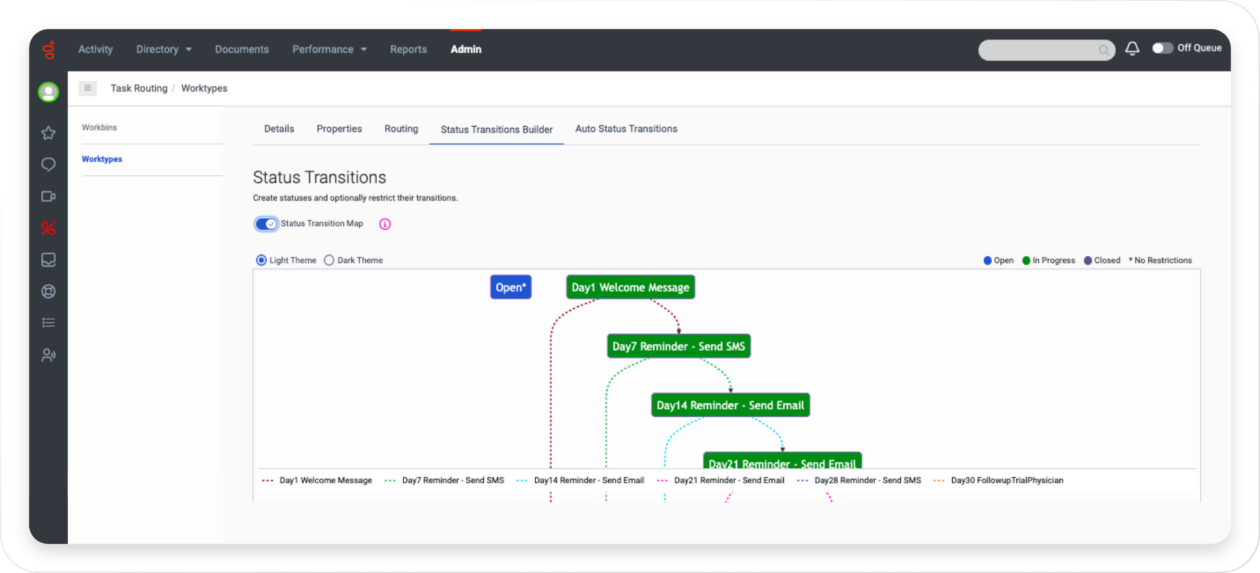Make more informed decisions based on accurate, current and consistent data. The Genesys work automation solution allows you to integrate siloed applications from multiple back-office systems.
Empower your team in real time by defining tasks based on SLAs and reprioritising work based on shifting business priorities. Guarantee that every customer request is handled on time and nothing is overlooked.
Stop guessing how long each customer request will take to complete. Accurately measure task completion time, status and employee performance with real-time insights across all work items.

Easily capture tasks from multiple sources and applications via API. Attach relevant attributes to help the system adjust to gain smarter prioritisation, distribution and context for all your employees.
Administrators can create configurable task stages and transitions to address more complex workflows. Choose from agent-assisted or fully unattended actions to deliver the right next step in every situation.
Task analytics provides a snapshot broken down by task type, process and location (queue vs. workbin), like work-item life report and average age. This knowledge improves employee skill sets and work balance.
Increase employee productivity with custom personal or group parking-lot queues (aka workbins). Your team leads will have complete visibility and control over task completion status and due dates, avoiding backlogs.
Control all captured task statuses, processing and assignments in real time from a single overview. Search, filter and take action when needed within one simple-to-use administration interface.
Design custom task statuses with automated and agent-assisted actions to eliminate backlogs. Enhance journey orchestration using proactive notifications, backend integrations and contact centre routing.

33%
of respondents cited siloed departments with separate customer engagement solutions as an organisational barrier to improving CX
The State of Customer Experience, Third Edition, Genesys, 2023
Providing a great customer experience is essential to business success, as research consistently shows. And the billions of dollars invested in front-end technologies prove that companies take this seriously. But what about the back office? Being able to track and trace customer requests throughout their lifecycle within the back office plays a critical role in the overall customer experience.
Combine the power of workforce automation and agent-assisted actions to provide consistent end-to-end experiences. Make business decisions in real time with a single source of truth powered by consistent data. You will no longer have to rely on an admin manager’s “best guess” for prioritising and assigning tasks. See what the future of work can look like.
Disparate systems, manual workarounds and the inability to track or trace the status of tasks have created many headaches for organisations — from small business to enterprise. This results in missed deadlines, human error and backlogs of work, which lead to frustrated and dissatisfied customers. And it only takes five bad experiences to lose a customer. Gaining transparent, reliable insights into your back-office tasks is paramount to the success of delivering on your customer promises.
Constantly pulling data from your CRM system, Excel databases and homegrown solutions is time-consuming and costly. It also requires you to make decisions based on inconsistent data entered in different ways, using different values. Genesys gives you APIs to integrate all your siloed systems — such as Salesforce or ServiceNow — into a single view, enabling business owners to make more informed decisions based on accurate and consistent data in real time.
The Genesys work automation solution allows a supervisor to classify and prioritise job creation tasks based on SLAs, such as time to completion, and reprioritise tasks based on shifting business priorities in real time. You can also enable the agent to select tasks based on business goals and task importance.
Avoid backlogs by creating automated task prioritisation and progression rules. Define baseline priorities easily, depending on task types and desired SLAs, as well as automatic actions to take once the status has changed. You’ll always meet due dates and you won’t have to worry about backlogs anymore.
Deliver on customer promises by obtaining complete visibility and accountability in the call centre. Prioritise, distribute and automate tasks in a single place, consolidating and controlling all contact centre tasks with ease. And analyse work to drive efficiency in real time. Boost productivity and deliver results through intelligent work automation tools, ensuring a seamless and effective customer experience.
We’ll contact you directly to set up a date and time that works with your schedule.
Work automation in a contact centre involves deploying technology to streamline and handle various customer requests or tasks through a set of actions called a “workflow.” These workflows generally employ both attended (i.e., human agents) and unattended (i.e., artificial intelligence and bots) resources to solve customer issues.
Work automation can streamline or entirely handle tasks like data entry, proactive notifications or contact strategies, and even some customer interactions. AI, chatbots and automated systems can manage repetitive inquiries, while more complex tasks are elevated to human agents. This automation enhances efficiency, shortens wait times and improves the overall customer experience within the contact centre.
A customer task or customer work item is any type of request submitted by or on behalf of a customer, regardless of the origin or interaction method. This can include a wide range of interaction channels, including contact centre interactions (phone, email or chat), self-service portals, mobile apps and social media.
Some examples of common types of work items include:
Customer tasks generally do not require immediate, real-time responses like a live chat interaction would. But they do often have defined timeframes for resolution via service level agreements (SLAs), such as a 24–48 hour response window.
Customer work items can be addressed through various methods, including:
Workplace automation in a call centre offers several benefits. It optimises efficiency by handling routine tasks like call routing or data entry, reducing agent workload and minimising errors. Automation enhances customer service by providing quicker responses and freeing up agents to focus on complex inquiries, improving overall service quality. It boosts employee satisfaction by allowing them to engage in more challenging and fulfilling tasks. Ultimately, automation in a call centre streamlines operations, elevates service standards and contributes to a more effective and rewarding work environment.
Work automation for claim processing in insurance uses technology to streamline and speed up the process. It automates repetitive tasks like:
This frees up adjusters to focus on more complex cases, and it provides faster service to customers.
Most commonly, work automation is employed in the financial services industry, insurance, business process outsourcers (BPOs), government agencies, telecommunications and cable providers, retailers (especially eCommerce) and utilities.
But from healthcare to retail, nearly any industry can benefit from work automation tools. If your business engages in customer relationship management in any form, you can reap the benefits of automation. This includes higher productivity resulting from less manual tasks, better work life balance from less workday stress, and higher customer satisfaction as their needs are met more quickly and more accurately, with more queries solved the first time without human intervention.
Workforce automation streamlines business processes in customer service and HR management alike. From a human resources and workforce management perspective, it removes manual tasks and results in less time spent on low-impact work. This means that your employees can dedicate their time and energy to higher priority tasks, and new employees get up to speed more quickly. This could mean supporting customers with more complex inquiries or developing new skills.
Proper preparation is key. First identify high-impact customer-facing processes, and then assess their automation potential. Consolidate all of your customer interactions within a single platform to ensure you have the full view of your customer journey. Map all your end-to-end processes, and begin to incorporate artificial intelligence (AI) to perform tasks like scoring and profiling and also to assist employees in real time with the most complex requests.
The right tools are critical to an effective work automation implementation. Without a robust AI foundation, no work automation solution can reach its full potential. The automated software has to be able to properly identify the right tasks to take out of the agent pipeline to be handled automatically, and through capabilities like machine learning, it should be able to adapt to changes within the customer support ecosystem.
Additionally, for work automation to work well for an organisation, buy-in is important, from the business owner all the way to every employee. AI can be scary, but the goal of work automation is to make employees’ work easier, not replace them. Making that clear can make a world of difference.
Work automation can help employees in almost any setting. But the idea should be just that — to assist and supplement the efforts of a human — rather than trying to fully automate systems or turn automation into a silver bullet to solve all customer service queries. Artificial intelligence is becoming more advanced all the time, but while AI can mimic things like creativity and empathy, the real things still require a human touch. For that reason, work automation should be used for easing the burdens of human customer service agents by handling routine queries — and then when things get more complicated, a person can step in.